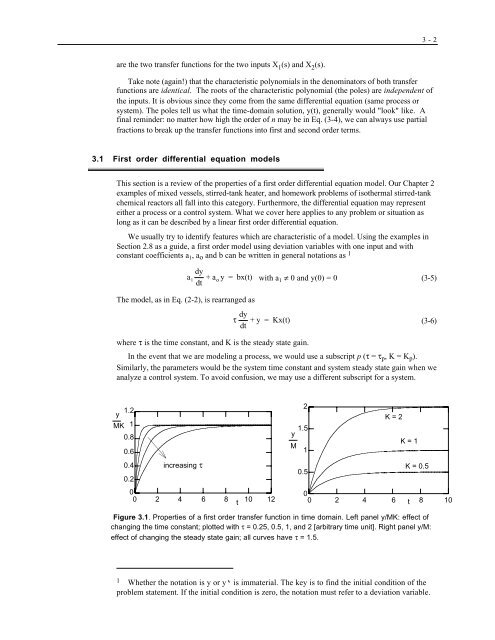Chemical Process Control a First Course with Matlab
Chemical Process Control a First Course with Matlab
Chemical Process Control a First Course with Matlab
Create successful ePaper yourself
Turn your PDF publications into a flip-book with our unique Google optimized e-Paper software.
3 - 2<br />
are the two transfer functions for the two inputs X 1 (s) and X 2 (s).<br />
Take note (again!) that the characteristic polynomials in the denominators of both transfer<br />
functions are identical. The roots of the characteristic polynomial (the poles) are independent of<br />
the inputs. It is obvious since they come from the same differential equation (same process or<br />
system). The poles tell us what the time-domain solution, y(t), generally would "look" like. A<br />
final reminder: no matter how high the order of n may be in Eq. (3-4), we can always use partial<br />
fractions to break up the transfer functions into first and second order terms.<br />
3.1 <strong>First</strong> order differential equation models<br />
This section is a review of the properties of a first order differential equation model. Our Chapter 2<br />
examples of mixed vessels, stirred-tank heater, and homework problems of isothermal stirred-tank<br />
chemical reactors all fall into this category. Furthermore, the differential equation may represent<br />
either a process or a control system. What we cover here applies to any problem or situation as<br />
long as it can be described by a linear first order differential equation.<br />
We usually try to identify features which are characteristic of a model. Using the examples in<br />
Section 2.8 as a guide, a first order model using deviation variables <strong>with</strong> one input and <strong>with</strong><br />
constant coefficients a 1 , a o and b can be written in general notations as 1<br />
The model, as in Eq. (2-2), is rearranged as<br />
a 1<br />
dy<br />
dt +a o y = bx(t) <strong>with</strong> a 1 ≠ 0 and y(0) = 0 (3-5)<br />
τ dy<br />
dt<br />
+y = Kx(t) (3-6)<br />
where τ is the time constant, and K is the steady state gain.<br />
In the event that we are modeling a process, we would use a subscript p (τ = τ p , K = K p ).<br />
Similarly, the parameters would be the system time constant and system steady state gain when we<br />
analyze a control system. To avoid confusion, we may use a different subscript for a system.<br />
y<br />
1.2<br />
MK 1<br />
0.8<br />
0.6<br />
0.4 increasing τ<br />
0.2<br />
0<br />
0 2 4 6 8<br />
t<br />
10 12<br />
2<br />
K = 2<br />
1.5<br />
y<br />
M<br />
K = 1<br />
1<br />
0.5<br />
K = 0.5<br />
0<br />
0 2 4 6 t 8 10<br />
Figure 3.1. Properties of a first order transfer function in time domain. Left panel y/MK: effect of<br />
changing the time constant; plotted <strong>with</strong> τ = 0.25, 0.5, 1, and 2 [arbitrary time unit]. Right panel y/M:<br />
effect of changing the steady state gain; all curves have τ = 1.5.<br />
1 Whether the notation is y or y‘ is immaterial. The key is to find the initial condition of the<br />
problem statement. If the initial condition is zero, the notation must refer to a deviation variable.



